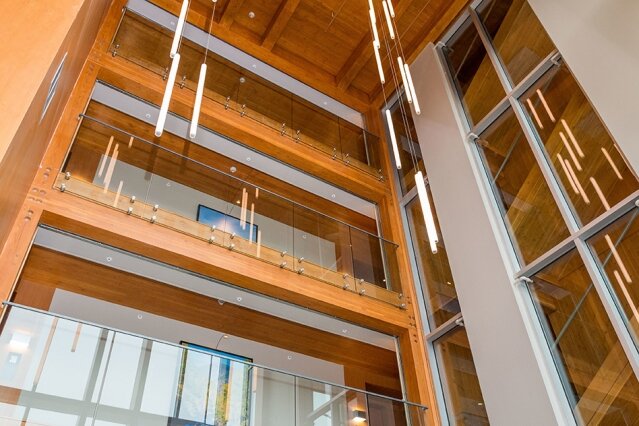
To meet the long-term goals of the Paris Agreement on climate change—keeping global warming well below 2 degrees Celsius and ideally capping it at 1.5 C—humanity will ultimately need to achieve net-zero emissions of greenhouse gases (GHGs) into the atmosphere. To date, emissions reduction efforts have largely focused on decarbonizing the two economic sectors responsible for the most emissions, electric power and transportation. Other approaches aim to remove carbon from the atmosphere and store it through carbon capture technology, biofuel cultivation, and massive tree planting.
As it turns out, planting trees is not the only way forestry can help in climate mitigation; how we use wood harvested from trees may also make a difference. Recent studies have shown that engineered wood products—composed of wood and various types of adhesive to enhance physical strength—involve far fewer carbon dioxide emissions than mineral-based building materials, and at lower cost. Now new research in the journal Energy Economics explores the potential environmental and economic impact in the United States of substituting lumber for energy-intensive building materials such as cement and steel, which account for nearly 10 percent of human-made GHG emissions and are among the hardest to reduce.
"To our knowledge, this study is the first economy-wide analysis to evaluate the economic and emissions impacts of substituting lumber products for more CO2-intensive materials in the construction sector," says the study's lead author Niven Winchester, a research scientist at the MIT Joint Program on the Science and Policy of Global Change and Motu Economic and Public Policy Research. "There is no silver bullet to reduce GHGs, so exploiting a suite of emission-abatement options is required to mitigate climate change."
Comparing the economic and emissions impacts of replacing CO2-intensive building materials (e.g., steel and concrete) with lumber products in the United States under an economy-wide cap-and-trade policy consistent with the nation's Paris Agreement GHG emissions-reduction pledge, the study found that the CO2 intensity (tons of CO2 emissions per dollar of output) of lumber production is about 20 percent less than that of fabricated metal products, under 50 percent that of iron and steel, and under 25 percent that of cement. In addition, shifting construction toward lumber products lowers the GDP cost of meeting the emissions cap by approximately $500 million and reduces the carbon price.
The authors caution that these results only take into account emissions resulting from the use of fossil fuels in harvesting, transporting, fabricating, and milling lumber products, and neglect potential increases in atmospheric CO2 associated with tree harvesting or beneficial long-term carbon sequestration provided by wood-based building materials.
"The source of lumber, and the conditions under which it is grown and harvested, and the fate of wood products deserve further attention to develop a full accounting of the carbon implications of expanded use of wood in building construction," they write. "Setting aside those issues, lumber products appear to be advantageous compared with many other building materials, and offer one potential option for reducing emissions from sectors like cement, iron and steel, and fabricated metal products—by reducing the demand for these products themselves."
Funded, in part, by Weyerhaeuser and the Softwood Lumber Board, the study develops and utilizes a customized economy-wide model that includes a detailed representation of energy production and use and represents production of construction, forestry, lumber, and mineral-based construction materials.
More information: Niven Winchester et al. The economic and emissions benefits of engineered wood products in a low-carbon future, Energy Economics (2019). DOI: 10.1016/j.eneco.2019.104596
Citation: Taking the carbon out of construction with engineered wood (2019, December 12) retrieved 12 December 2019 from https://techxplore.com/news/2019-12-carbon-wood.html
This document is subject to copyright. Apart from any fair dealing for the purpose of private study or research, no part may be reproduced without the written permission. The content is provided for information purposes only.
